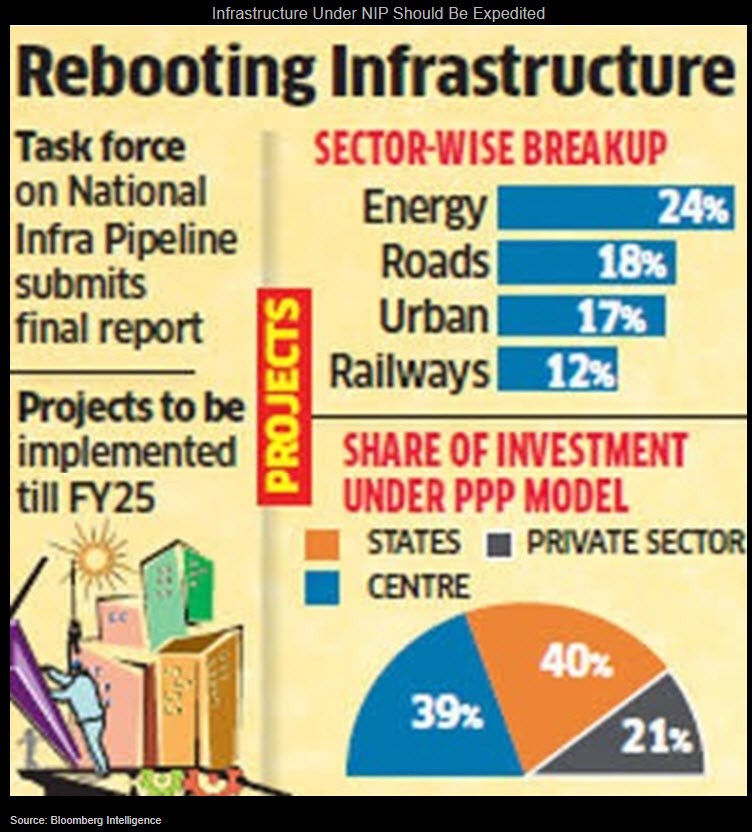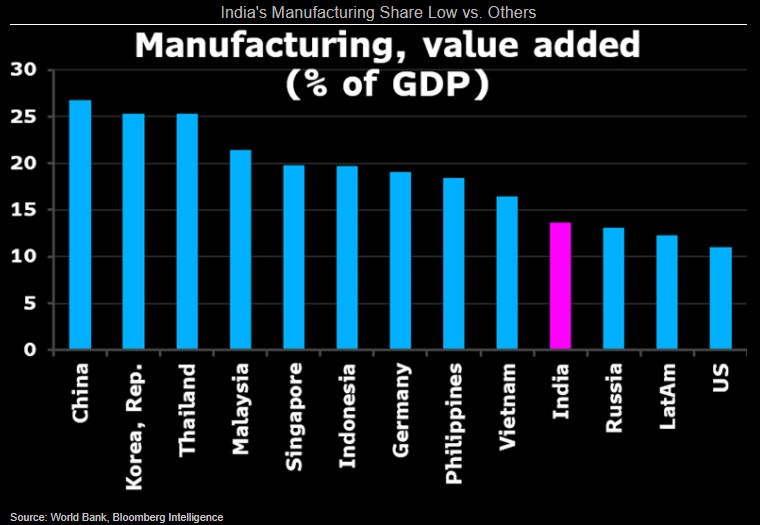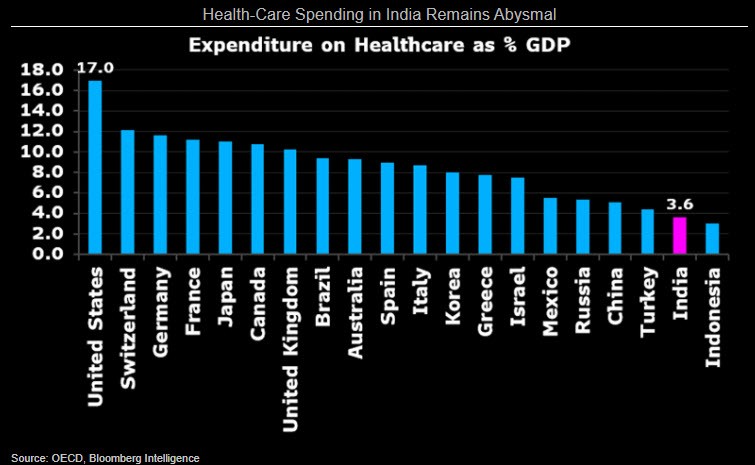Five ways India can create a $5 trillion economy post-pandemic
This analysis is by Bloomberg Intelligence Head-EM Equity Strategy Gaurav Patankar and Strategist Nitin Chanduka. It appeared first on the Bloomberg Terminal.
India has a credible path to emerge from its COVID-19 crisis if it focuses on what we see as five priorities: Aim for greater, faster divestitures; boost the middle class by abolishing personal taxes; accelerate the infrastructure pipeline; build on manufacturing momentum; and make bold, outcome-oriented investments in health care.
Raise divestiture target: $200 billion over 4 years
India’s resolve to sell stakes in Public Sector Enterprises (PSEs) could be a game-changer for the economy and help fund capital expenditures. In fiscal 2022, the government has budgeted $25 billion from stake sales in PSEs and financial institutions. It looks ambitious, yet we reckon the total value of the government stake in the BSE PSU Index (BSETPSU) is $170 billion, almost 7x the 2022 divestiture target. Including stake-sale proceeds from unlisted firms, the government could pull in $200 billion in revenue over the next four years, which can be used to stimulate the economy.
To add accountability, private-sector experts should be appointed as joint secretaries to the privatization department, while approval steps should be limited to expedite decisions.

Boost the middle class: Eliminate income tax
Abolishing personal taxes in India could be the biggest stimulus to the economy, making the country an attractive hub for global talent and foreign investment. The contribution of income taxes in India is 2.5% of the GDP, quite low compared with most other countries. Only a quarter of the overall tax revenue is collected via the income levy, with corporate accounting for 25%, and indirect — primarily the Goods and Services Tax (GST) — 50%. About 2-3% of Indians pay income taxes and mostly comprise the salaried class. Slashing or reducing personal tax rates will likely incur a fiscal burden of 2-3% of GDP.
A part of the revenue shortfall can be recovered from higher indirect taxes demand gets a boost from increased disposable income.

Speed up $1.4 trillion infrastructure plan
India needs to focus on outcome-driven infrastructure spending by charting a 10-year fiscal path for rating agencies. Dedicated focus on building new cities, ports, bridges, high-speed rail and highways will have a multiplier effect on jobs and help reduce unemployment. Projects as part of National Infrastructure Pipeline (NIP), with capital spending of $1.4 trillion, should be expedited and monitored against timelines. For funding, private financiers, off-balance sheet funding, overseas pensions and insurance capital should be sought, with a quasi-sovereign guarantee.
Any wastefulness because of higher infrastructure spending won’t be a concern in the long run, as the economic stimulation will likely outweigh short-term funding pressure.

Covid-19 brought manufacturing skill to the fore
Amid the Covid-19 crisis, India became the largest producer of personal protective equipment (PPE), which is a testimony to the country’s manufacturing prowess. Before the pandemic, India was a net importer of PPE kits. However, amid import bans and within a span of two months, the country became self-reliant for PPE and started exporting the kits. The government should capitalize on this momentum and aggressively set out to become self-reliant. As companies adapt the “China + One” strategy, India’s government must show its intent with faster land clearances, reduced bureaucracy and greater incentives to attract investments in sectors like medical textiles, smartphones and semiconductors.
Improvement in land and capital productivity, along with attracting longer-term capital, will support the “Make in India” initiative.

Increase health-care spending to 6% of GDP
India’s drastically low health-care spending must be increased through targeted, outcome-based stimulus. The pandemic has starkly illustrated India’s inadequate health-care spending, hovering near 3.6% of GDP, according to the Organization for Economic Cooperation and Development (OECD). Other OECD countries spend an average of 8.8% of GDP, while the other BRICS nations — Brazil, Russia, China and South Africa — are at 6.3%. To improve the skewed distribution of medical facilities, India could provide incentives for doctors and entrepreneurs to set up hospitals in rural areas.
Direct-benefit transfers could be in the form of skill credits for medical workers or enticements to establish up medical colleges in villages.
